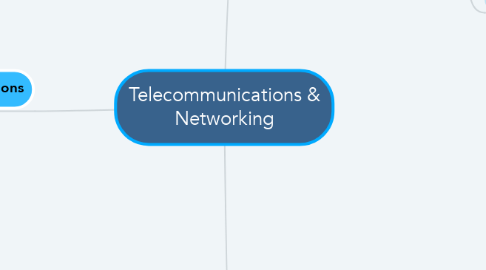
1. What is computer network ?
1.1. Local Area Netwrok
1.1.1. connect >2 devices so that every device on the network can communicate with other device
1.1.2. many LAN have file server contain various software & data
1.2. Wide Area Network
1.2.1. cover large area
1.2.2. contains routers
1.2.3. does not exists until LAN appeared
1.3. Enterprise Network
1.3.1. LAN & WAN interconnected
2. The Internet & the World Wide Web
2.1. Accessing the Internet
2.1.1. Intranet
2.1.1.1. use internet protocols
2.1.1.2. support discovery, communication, collaboration
2.1.2. Extranet
2.1.2.1. connects part of the intranet
2.1.2.2. enables business partners communicate securely using virtual private network
2.1.3. Online Service
2.1.3.1. access internet using ISP Internet service provider
2.1.3.2. ISP connect to one another through NAPs
2.1.4. Other Means
2.1.4.1. Dial Up
2.1.4.2. Cable Modem
2.1.4.3. Satellite
2.1.5. Addresses on the Internet
2.1.5.1. IP Address distinguishes from other computers
2.2. Future of the Internet
2.2.1. factors cause internet brownout
2.2.1.1. no of people work online
2.2.1.2. soaring popularity of Web sites
2.3. World Wide Web (WWW)
2.3.1. a system accept standards for storing,formatting & displaying information
2.3.1.1. web sites
2.3.1.2. Webmaster
2.3.1.3. URL
2.3.1.4. Browser
3. Network Applications
3.1. Discovery
3.1.1. Search engines & Metasearch engines
3.1.2. Publications of Material in Foreign
3.1.3. Portals
3.1.3.1. commercial portal
3.1.3.2. affinity portal
3.1.3.3. corporative portal
3.1.3.4. industrywide portal
3.2. Communications
3.2.1. E-mail
3.2.2. Web-Based Call Centers
3.2.3. Electronic chat rooms
3.2.4. Voice communication
3.2.5. UC
3.3. Collaboration
3.3.1. work group
3.3.2. workflow
3.3.3. virtual team
3.3.4. virtual collaboration
3.3.5. crowdsourcing
3.3.6. synchronous vs asynchronous
3.4. E-Learning & Distance Learning
3.5. Virtual universities
3.5.1. students take classes via internet
3.6. Telecommuting
3.6.1. workers are able to work anywhere anytime
